

Building a better role-playing game story. This is a weekly column from freelancer Rowan Kaiser, which focuses on "Western" role-playing games: their stories, their histories, their mechanics, their insanity, and their inanity.

Getting story right in role-playing games is crucial. Even if narrative is not your primary motivator, it's a key element to the RPG genre. But not all role-playing games have discovered the right formula. Its been my experience that there's no set checklist to ensure a successful story, but I've found that there are key components that can appeal to players with a narrative focus. I'd love to say "follow these pieces of advice and make a great RPG story! " Balance the Antagonists: Getting a villain wrong is one of the most common mistakes of most video games, especially role-playing games. Developing Meaningful Player Character Arcs in Branching Narrative. A little background: During my years at BioWare, I found that despite the enormous amount of talent housed in the writing department, there were certain subjects for which we lacked a common language of craft -- a clear and broadly applicable way to discuss what worked, what didn't, and why.
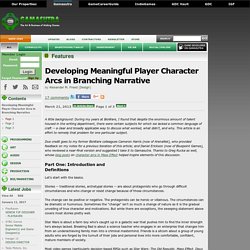
This article is an effort to remedy that problem for one particular subject. Due credit goes to my former BioWare colleagues Cameron Harris (now of ArenaNet), who provided feedback on my notes for a previous iteration of this article; and Daniel Erickson (now of Bluepoint Games), who reviewed a near-final version and suggested I take it to Gamasutra. Thanks to Greg Rucka as well, whose blog posts on character arcs in Mass Effect helped inspire elements of this discussion.
Let's start with the basics. Stories -- traditional stories, archetypal stories -- are about protagonists who go through difficult circumstances and who change or resist change because of those circumstances.
Rayman Origins designer Chris McEntee's rational approach to game design. In Gamasutra's latest feature, Rayman Origins designer Chris McEntee explains Ubisoft's "rational design" approach, and why he believes it's a key to success in the game design field.

Conceived by several Ubisoft veterans, the rational game design method was implemented in the publisher's sidescrolling game Rayman Origins, which was praised by critics and gamers alike as one of last year's best platformers. McEntee explains, "Rational design is all about eliminating unnecessary information, making things inherently readable, understandable and apparent, introducing mechanics in an orderly and easily digestible fashion, and preserving the learning and difficulty curves of a game, known as macro flow. Boss Battle Design and Structure. Boss Battle Design and Structure By Mike Stout [In his latest design feature, Activision and former Insomniac designer Mike Stout breaks down the boss battle into eight different beats, and runs two notable ones -- The Legend of Zelda: Ocarina of Time's Ganon and Portal's GladOS -- through a thorough analysis to illuminate their designs.]
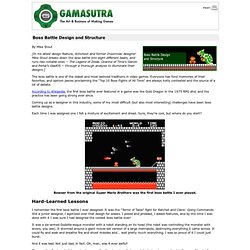
The boss battle is one of the oldest and most beloved traditions in video games. Joost Rietveld's Blog - Partnering vs. self-publishing: how independent should you really be? Partnering vs. self-publishing: how independent should you really be?

The following blog post, unless otherwise noted, was written by a member of Gamasutra’s community. The thoughts and opinions expressed are those of the writer and not Gamasutra or its parent company. “We do not write a marketing plan, marketing doesn’t work.” – Indie developer in recent email conversation Independent game studios have the tendency to revert from publishing partners when it comes to commercializing their games on digital distribution channels. Doing it yourself is implicitly assumed by adopting the label ‘independent’ and has certain obvious advantages such as (creative) freedom and greater revenue per unit sold. RAD Game Tools. The Independent Games Festival is Fine - You are the Problem. Yesterday, the Rotting Cartridge ran a piece explaining why they believe the judging process for the Independent Games Festival is broken, based on their experiences with a game they submitted to the festival, Kale in Dinoland.

During the course of that article, they reprinted a piece of private correspondence from the IGF’s organizers and saw the lack of attention their magnum opus (a monochromatic Game Boy-style platformer) received as evidence that the festival is a corrupt and contemptible institution. Jenn Frank was not amused. My friend was right when he warned me not to get so agitated. “It’s scene drama,” he told me. He is correct. I have been privy to scene drama, not only in videogames, but among otherwise-wonderful poetry communities, among fiction writing majors, theater schmoes, whoever. I really hate to suggest it, but maybe the problem was your game. Features - Learning From The Masters: Level Design In The Legend Of Zelda. When going back to replay classic games I played as a kid to mine them for knowledge, I always fear that any games from the NES era or earlier are too old to learn much from.

I tend to assume that many elements of modern design will be missing: no training, bad difficulty ramping, haphazard level design, and so forth. Before writing this article, I was under the impression that many "good design principles" I've come to know and love were invented during the SNES era and iterated on from there. Zelda: Wind waker Tech and Texture Analysis *picture heavy* So After this little thread: i felt like the opinion was more yay than nay. it seamed people are (just like me) highly interested in "how" wind waker was made.
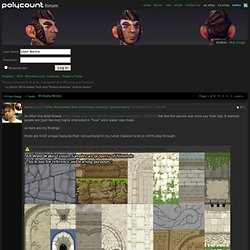
Level Design and Procedural Generation in Shattered Planet. Overview Tanya here!
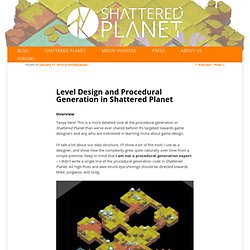
This is a more detailed look at the procedural generation in Shattered Planet than we’ve ever shared before!
Typography. Profiles : Yahtzee Croshaw : Posts. The four lenses of game making. [In this opinion piece originally posted on the What Games Are blog, and reprinted in full with his permission, UK-based game designer Tadhg Kelly breaks down the four lenses of game making, a "common set of assumptions and predispositions" he often sees in developers.]
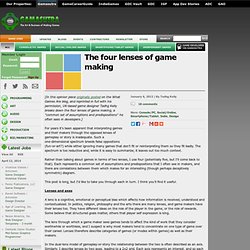
For years it's been apparent that interpreting games and their makers through the opposed lenses of gameplay or story is inadequate. Such a one-dimensional spectrum breeds false oppositions (fun-or-art?) While either ignoring many games that don't fit or reinterpreting them so they fit badly. The spectrum is too reductive and, while it is easy to summarize, it leaves out too much context. Rather than talking about games in terms of two lenses, I use four (potentially five, but I'll come back to that). Game Dynamics and Loops [Game Design. Numina [Games and Fantasy. We often infer more from a game experience than is actually on the screen.
We have the capacity to use the game as an imaginative springboard, inferring personality traits, characters, behaviours and a sense of a larger game world beyond even what the developer intended. We make cognitive leaps, little observations and associations that contain the quality of empathy, and so it feels like there is more there than meets the eye. Videogames are capable of inspiring this sense, just as great novels and movies can, and this is why they are an art.
I call these moments numina. Numina are the gateway to achieving magical engineering, and so they are an essential part of what games are. Peripheral Perception The players thought that they could see subtle effects in how the footballers acted, momentary actions and other patterns that were not actually in the game.